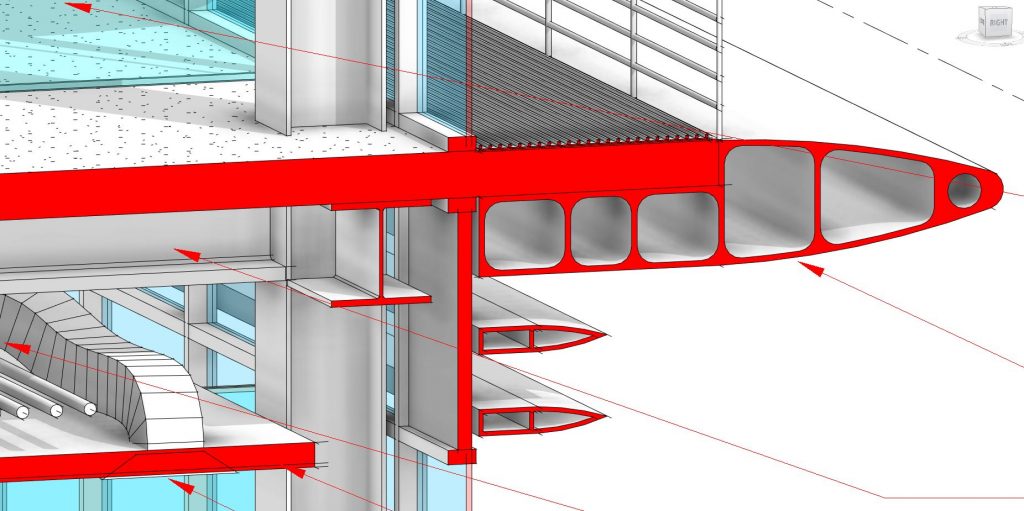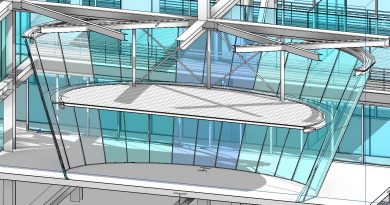Model everything like a “Design Scientist” (Homage to Buckminster Fuller )


DESIGN SCIENCE
Amy Edmondson
From A Fuller Explanation, pages 258-259
“I did not set out to design a geodesic dome,” Fuller once said, “I set out to discover the principles operative in Universe. For all I knew, this could have led to a pair of flying slippers.” This playful declaration stands as a concise summary of the philosophy behind Fuller’s life’s work and introduces the relationship of synergetics to design. “Design science,” in the most general terms, maintains that faithful observation of Universe is the basis of successful invention. The idea therefore is not to invent some strange new gadget, hoping there will be a market for it, but rather to tap into the exquisite workings of nature. While the significance of scientific discoveries is not always immediately understood, the accumulated “generalized principles” have been applied in innovative ways throughout history, producing artifacts which have gradually transformed the physical environment. Therein lies the key to humanity’s success aboard Spaceship Earth, explains Bucky Fuller.
“COMPREHENSIVE ANTICIPATORY DESIGN SCIENCE”
Characteristically, his title expands to embrace the full significance of this vital human endeavor.
Fuller defines design as the deliberate ordering of components. Thus distinguished from randomness, design implies the presence of intellect. His definition is worth our serious attention, for the word is too often associated with the concept of decoration-secondary or superficial embellishment as opposed to thoroughly developed systems. Fuller was quick to point out that Universe overflows with evidence of design; unimaginably intricate and reliable energy patterns reveal “eternal design interrelationship principles.” Technology, to Fuller, is principle in action, and so “Universe is nothing but incredible technology.” Its awesome complexity is the inspiration for Fuller’s phrase “Intellectual Integrity of Eternally Regenerative Universe”, a weighty title attempting to convey a nonanthropomorphic respect for a greater (in fact all-encompassing) divine intelligence.
Combining this newly defined word with “science,” to describe a new discipline or field, further enriches its significance. “Science” hints at the necessary rigor, suggesting a systematic new study. Fuller thereby expands the realm of “design”; the scientific method is essential, for “design science” involves the application of principle. He points out that “generalized principles” are eternal truths, as opposed to special-case statements or transient facts, and as such are inherent aspects of reality waiting to be discovered. Only human beings are able to discern such truths (science) and thereby participate in their own evolution (design). “Design science” is thus saturated with meaning: humanity alone has access to the design laws of Universe, and that has determined our unique evolutionary function. Just as bees are meant to cross-pollinate, we are meant to solve problems. Without specialized long beaks or wings or other role-specific physical traits, human beings have learned to exploit mechanical advantage, discipline the electron, travel more quickly than the fastest leopard, and fly farther than the strongest bird. Our unique advantage is a faculty called “mind,” which can integrate disparate facts of experience. We are therefore deliberately designed to be “comprehensivists” while all other creatures are specialists. This brings us to the next aspect of Fuller’s wordy title.
“COMPREHENSIVE…”
Fuller was profoundly impressed by the danger of overspecialization. He was once asked to speak at a convention of the American Association for the Advancement of Science, and the experience provided one of his best parables. Whether by luck or through Fuller’s characteristic genius for detecting significant patterns, he happened to encounter two papers with a striking similarity presented at different sections of the conference. The reports, on biology and on anthropology, both happened to discuss the phenomenon of extinction: the former investigating various extinct species, and the latter, extinct human tribes. Both papers concluded that the cause of extinction was overspecialization, which, taken to an extreme, precludes general adaptability. Fuller took the message to heart.
He says his predilection for thinking comprehensively began with his World War I Navy experience. Belonging to the last generation of sailors that preceeded ship-to-shore radiotelephone equipment, officers in 1917 were still trained as “comprehensivists.” Everyone had to be capable of handling any job on the ship, for voice communication with land was not yet possible. The need for all members of a crew to act quickly in an emergency demanded quick “comprehensive” thinking and the flexibility to take over any job without instructions from superior naval powers. A second lesson was that a sailing vessel is itself a managable whole system, and every member of her crew is working toward the success of the whole ship. It seemed to Bucky a very desirable way to operate. He began to see that our entire planet is one system and deliberately set out to understand the interrelatedness of human affairs. He later coined the famous “Spaceship Earth” to symbolize this approach, as it became ever more apparent that effective design had to recognize the existence of a finite and inescapably connected whole-system world. Lack of such awareness leaves us stranded on a ship with the starboard side short-sightedly using much of its time and energy in an effort to sink the port side, and vice versa.
Fuller then calls our attention to a subtle irony implicit in the compartmentalization of the sciences, which require an ever narrower focus as one pursues a given scientific discipline more deeply, as if to deny the relatedness of various aspects of scientific knowledge. At the beginning of this century, he recalls, chemistry and biology, for example, were totally separate fields, the former encompassing chemical elements and their reactions, the latter pondering the classification of species and the mystery of evolution. Moreover, all branches of science involved philosophical speculation. Time was given to questions such as “what is life?” and the difference between life and nonlife could not have seemed more self-evident.
In this century, however, science faced an unpredicted development. As a necessary reaction to new discovery, new fields emerged, such as biochemistry, defying the rigid boundaries between disciplines. (Science responded by making individuals that much more specialized within such new categories, laments Fuller.) More sophisticated equipment had revealed the chemistry of life, forcing scientists to integrate their fields. The helix of nucleotides in DNA, the magnificent chemical transitions in photosynthesis, and hundreds of newly observed reactions belonged inarguably to both chemistry and biology, and precipitated the birth of “biochemistry.” And gradually the clear boundary between life and nonlife was dissolving, for both consist ultimately of electrochemical process. But scientists were no longer the “natural philosophers” characteristic of the turn of the century, maintains Fuller, and so this astonishing evolution went largely unheralded. Specialization removed the burden of asking what a scientific development means in terms of the whole picture.
Fuller has a reason for pointing out such historical trends: the design scientist will be maximally effective as a comprehensive thinker. Once again, he redefines and thereby expands the concept of design. The design scientist is not to be concerned with an attractive handle for refrigerator doors, but rather with the whole concept of the distribution and preservation of food for humanity. Such subjects, he emphasizes, are not too large to think about. Only through systematic comprehensive planning does humanity have a chance to survive its growing crisis.
A “comprehensivist,” he continues, may periodically have to “plunge very deeply” into a narrow subject or specialized project; however, such activity is always part of a larger plan. “Local problem solvers” can function with a global perspective. Our emphasis must shift from “earning a living” to accomplishing vital tasks if humanity is to survive, cautions Fuller; moreover, the “living” will take care of itself if we concentrate on doing what needs to be done.
These sweeping statements at first may seem difficult to apply; however, Fuller’s philosophy is backed up by a lifetime of revolutionary invention and research into world patterns and trends, which stem directly from his 1927 decision to think about the whole system of “Spaceship Earth.” He explains that his accomplishments were only possible because he gave himself the license to be a generalist: it is feasible to conceptualize humanity’s food production and distribution (for example) as a whole system; it is a complicated study, but one with clearly defined boundaries: just food, where it is grown, where and when it is eaten, how and at what cost to the environment, consumer, etc. (1)
“…ANTICIPATORY…”
Finally, the design scientist must think ahead. In each industry, there are specific “gestation rates” that determine the length of time between invention and widespread practical application. These inherent lags vary according to the nature of a design: in the electronics industry, for example, it is only a matter of months before a new invention can be incorporated into commercial production; car manufacturers might require five years to bring a new idea to the consumer; and housing presents the slowest evolution of all, Fuller’s rather optimistic estimate of the ‘gestation rate’ being fifty years. Psychological resistance to change, absence of urgency, and ignorance keep our approach to housing many generations behind our technological capability. The design scientist must take these lags into consideration, explains Fuller; an invention often must wait until its time, but the designer has a responsibility to anticipate long-term developments. Finally, a necessary implication is that we can glean important clues through the study of trends, and thereby determine what needs to be done.
So let us look at the relationship between “comprehensive anticipatory design science” and synergetics. Invention, as stated above, is the novel application of one or more “generalized principles.” In the previous chapter, we discussed two inventions, the geodesic dome and tensegrity structures, in light of this statement. Briefly, the dome combines the inherent stability of triangles with the advantageous volume-to-surface-area ratio of spheres. A variety of structures based on geodesic chords could satisfy the above requirements, but icosahedral symmetry approximates the spherical distribution most efficiently. Both geodesic domes and tensegrities are direct applications of the principle describing the specific interdependence of tension and compression.
The theory of geodesic domes is taken a step further by an additional principle: the varying rates of geometric expansion. As discovered and exploited long ago by clipper-ship owners as well as by today’s shipping industry, a ship with twice the length of another has eight times the volume and four times the surface area. Translated into practical advantage, the cargo (i.e. payload) of larger vessels increases rapidly with respect to the amount of material and drag, which together determine the effort and cost of building ships and driving them through the sea. Larger ships are therefore more cost-effective. Despite the pivotal role of this geometric principle in shaping the historical direction of shipping, the flow of resources, and the ultimate mobility of humankind, these varying rates are not popularly recognized. With respect to geodesic domes, this means doubling the diameter increases the material fourfold and encloses eight times the volume. As both cost and temperature control of an enclosure are directly determined by surface area, the efficiency of a geodesic dome increases drastically with size. The implication is that their true design-science advantage is yet to be realized and may involve very large structures in novel environment control applications. Whether utilized for shelter, food production, recreation, or other functions, geodesic domes can enclose so much space with so little material that unprecedented future applications are not unlikely. In conclusion, the geodesic dome embodies design science at work.






